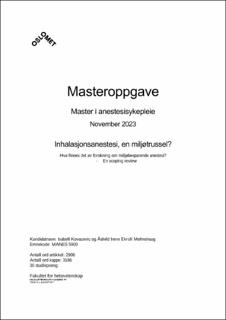| dc.description.abstract | Bakgrunn, hensikt og problemstilling: Verden står ovenfor klimakrise og global oppvarming, det er derfor kritisk at alle bidrar til å redusere miljøforurensning. Inhalasjonsanestesi er potente drivhusgasser som slippes direkte ut i atmosfæren daglig, verden over. Anestesisykepleieren spiller en aktiv rolle for å bidra til FNs bærekraftsmål om å stoppe klimaendringene. Hensikten med studien er å finne eksisterende og oppdatert forskning på behandlingsstrategier som kan bidra med å redusere klimautslipp til inhalasjonsanestesiens avfallsgasser.. Problemstillingen lyder som følger: Inhalasjonsanestesi, en miljøtrussel? Hva finnes det av forskning om miljøbesparende anestesi?
Metode: Gjennom en scoping review, ble det utført systematiske litteratursøk i databasene Medline, Embase og Scopus. Det ble inkludert fagfellevurderte studier av kvantitativ metode med ulike design. Analyseprosessen ble til gjennom en induktiv tilnærming. Masteroppgaven er utarbeidet i form av et artikkelmanus med kappe.
Resultatet: Det systematiske søket ga 184 treff, etter seleksjonsprosessen resulterte det i syv inkluderte studier. Samtlige av studiene omhandlet lav flow anestesi og lav flow anestesi i kombinasjon med undervisning, oppsamlingsenheter og teknologiske hjelpemidler. Tiltakene viser en reduksjon i utslipp av avfallsgasser fra inhalasjonsanestesi.
Konklusjon: Eksisterende forskning viser behandlingsstrategier som bidrar til reduksjon av avfallsgasser ved bruk av lav flow anestesi. Det er behov for mer forskning rundt oppsamlingsenheter og en utarbeidelse av en oversiktsartikkel på tema. Eventuelt vurdere andre anestesimetoder.
Background, purpose, and issue: The world is facing a climate crisis and global warming, making it critical for everyone to contribute to reducing environmental pollution. Inhalation anesthetics are potent greenhouse gases released directly into the atmosphere on a daily basis worldwide. The anesthesia nurses play an actively role in contributing to the achievement of the UN´s sustainable development goals to address climate change. The purpose to this article is to identify exciting and up-to date research on treatment strategies that can help reduce greenhouse gas emissions from the waste gases of inhalation anesthesia. The research question is as follow: Inhalation anesthesia, an environmental threat? What research exist on environmentally friendly anesthesia?
Method: Through a scoping review, systematic literature search was conducted in Medline, Embase and Scopus databases. Peer-reviewed studies with quantitative methods and various design were included. The analysis process was conducted through an inductive approach. The master´s thesis is presented in an article manuscript.
Result: The systematic search resulted in 184 hits, after the selection process, seven studies were included. All studies focused on low-flow anesthesia and low-flow anesthesia in combination with education, scavenging systems and technological aids. The strategies demonstrated a reduction in the emissions of waste gases from inhalation anesthesia.
Conclusion: Existing research highlights treatment strategies contributing to the reduction of waste gas emissions with use of low-flow anesthesia. Further research is needed on scavenging systems, and a systematic review article on the topic should be developed. Alternatively considerate other anesthesia methods. | en_US |
